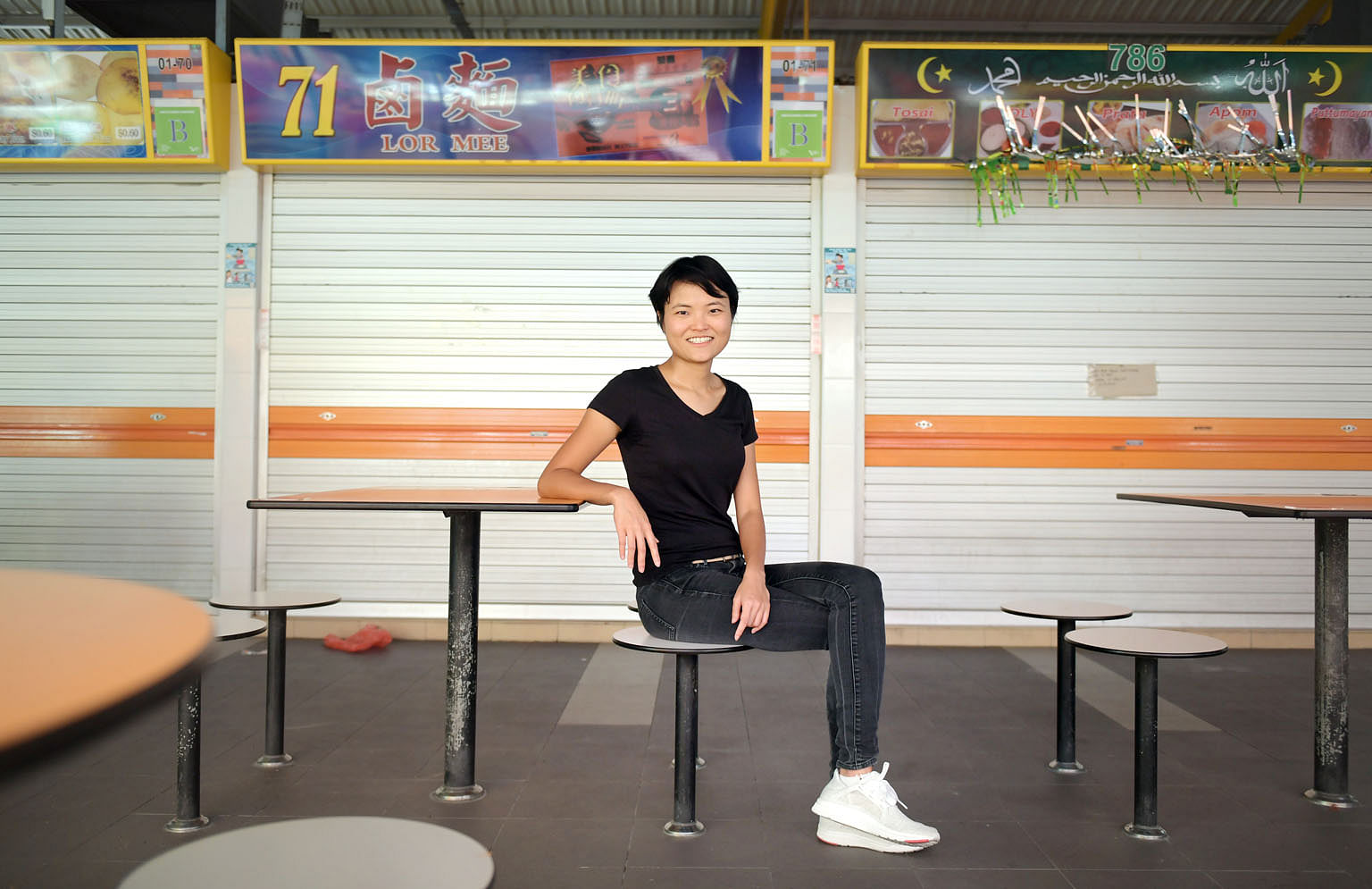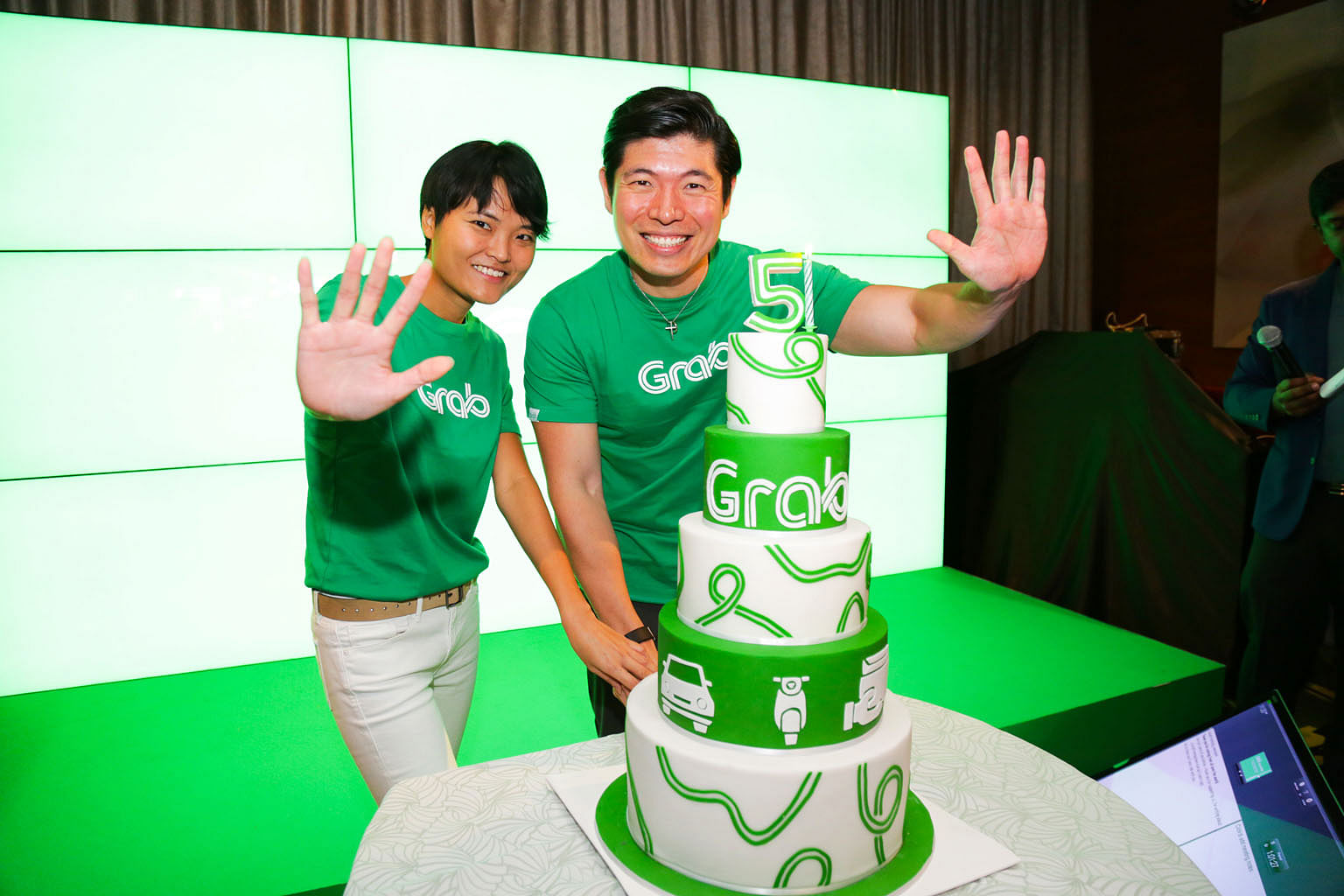I was planning to use GrabCar to get to my lunch with Ms Tan Hooi Ling, the co-founder of Grab.
But the night before, I heard how a private-hire car driver had to ask his passenger to guide him along the route. I didn't want to risk being late, so I called for a Comfort cab instead. The driver had no problems getting me there.
Ms Tan has chosen Bukit Merah View Market and Food Centre to meet. Her PR folks had assured me there was a reason for her choice.
It's a hot day and the centre is noisy, filling up fast with a lunch crowd. I settle at a table in the quietest corner I can find and message Grab's PR manager, Claire, to let her know where I'm sitting.
They arrive, via Grab, of course. Ms Tan, 33, whose title is both co-founder and chief operating officer, is tall and very slim. She's in a black T-shirt and jeans, both from Uniqlo, and white sneakers. She's barefaced except for a lick of lipstick, and carries a grey, haversack-styled bag.
She could pass off as a university student, except she is one-half of South-east Asia's most exciting start-up, Grab.
In 2012, she and fellow Malaysian Anthony Tan founded Grab in Kuala Lumpur. It set out to make taking taxis in KL safer by signing up taxi drivers whom customers could trust.
Today, Grab operates in 65 cities in seven countries, and its business is anchored on two planks - transport and e-payments. It offers rides via private cars, taxi partners, shuttle buses, bikes and social carpooling, as well as delivery services and e-payment solutions.
While Grab has yet to turn in a profit, it has already attracted more than US$1 billion (S$1.38 billion) in funding. Last Friday, the Wall Street Journal reported that it is raising a further US$2 billion from Japan's SoftBank Group and China's ride-hailing firm Didi Chuxing. The upcoming deal would value Grab at more than US$5 billion.
Its headquarters is here, in Sin Ming. Starting out with fewer than 10 people, it now has more than 2,000 employees.
While Mr Tan - Grab's other co-founder and its chief executive - has been the face of Grab, Ms Tan (they are not related) has been media-shy.
"In general, I prefer to be behind the scenes," she says when I thank her for agreeing to have lunch.
"You can think about it as going back to first principles. I'm introverted by nature, and also because I just enjoy getting work done and spending time out of the news."
But first things first. What shall we eat? She is practical. She says she chooses stalls with short queues. A queue indicates the food is good, and a short one means she won't waste too much time getting it.
In any case, Claire offers to order for us. We decide on Na Na Curry, which serves Chinese-style curry.
We're seated at a table for four with stools cemented to the floor. When Claire returns with the food, she's joined by Sophie from the PR agency servicing Grab.
With all the seats taken, I'm wondering where we should place our handbags. On the floor?

I look around and even before I have time to react, Ms Tan has taken charge of the situation.
She jumps from her stool, strides to a stack of red plastic chairs a few metres from us, and hauls over two of them. We put our handbags on the chairs. Problem solved.
"Bon appetit," Ms Tan says brightly.
She has a friendly, pleasant demeanour and, while she is clearly very bright, seems determined to stay humble and grounded.
She is eloquent, speaking passionately about Grab's work in long, fully formed paragraphs. Her accent has British and American inflections because she spent years in both countries.
She uses "awesome" a lot, but also terms like "synergistic investments", "scalability", "true value" and "learning cycles".
At one point, she asks for paper so she can draw out what Grab is about. She's a visual, whiteboard sort of person, she says, and needs to draw what she's saying "because otherwise I can talk to you, but I'm not sure if you understand what I mean".
You sense she needs focus and structure because twice during our wide-ranging conversation, she seeks to be clearer where all this is heading.
"Sumiko, I've not talked so much for a very long time," she says with a laugh at one point. "Why don't you tell us more about what you're looking for?" Later, she says again: "Sumiko, I have no idea where your interview direction is going to go."
I assure her that I want to know as much as I can about how she got to where she is.
Her life started ordinarily enough. She grew up in KL in a middle-class family. Her father is a civil engineer and mother a remisier. An older brother, now living in New Zealand, is a software programmer.
"We used to fight a lot but I love him like to - I don't want to use the word death, but that's how much I love him. A lot. I respect him a lot," she says. She adds that if I were to print this, "he probably will take a picture and send it to me with some crazy emoticons".
They lived in a semi-detached house in Petaling Jaya and she went to state schools. She liked sports like badminton and also played the piano and violin. She reluctantly reveals she has a diploma in piano and Grade 8 in violin but "please don't ask me to play anything right now".
She "fernangled" her parents to let her study mechanical engineering at the University of Bath in Britain. She'd always liked logic, physics and maths and enjoyed seeing her father tear apart stuff to try and fix it.
She took a year off during university to do an industrial placement at pharmaceutical company Eli Lilly's manufacturing plant in Basingstoke.

"I was helping them to figure out how to use their equipment more efficiently, health safety standards, all of those things. It was a really good learning opportunity."
But her biggest takeaway was that business decisions are made at management level. She went back to finish her engineering degree in Bath but also "decided to change my career trajectory".
"That's when I said: 'Hey, I need to step back.' Mechanical engineering, despite what I initially thought and loved, was not going to be the future I wanted to spend all my time on. What I wanted to do was really understand how businesses make decisions."
Back in Malaysia, she joined management consultancy McKinsey & Company and did projects in the region. She did well enough for them to sponsor her to Harvard Business School (HBS), and that was when her life really changed.
There were five Malaysians in the 2011 batch at HBS, which she says was "super unusual" as there are usually at most two. Among them was Mr Anthony Tan, whom she and the others knew as a scion of conglomerate Tan Chong Motor. Mr Tan is a grandson of the founder.
She thought to herself that "okay, he's probably very different from us because he comes from a rich family and when I meet him I'll meet him, but I have no real intent of going to meet him".
The first year, they met at the food gatherings Asian students had and got to know each other. She found him "very atypical" of a tycoon's son. "He's actually way more hardworking than I was, super humble and just a nice person to be with."
In the second year, they found themselves choosing the same two courses. One was Business at the Base of the Pyramid, which is about how business can play a significant role to improve the quality of life of the low-income, especially in developing countries.The other was Launching Technology Ventures.
They discovered they had the same world view. In the course of many discussions, they came up with a business idea to make taking taxis safer in KL. "We realised very quickly that, wow, there's really an opportunity to bring change and value here," she says.
They took this idea to a business plan contest held by HBS, which gave them access to external resources like advisers. They were runners-up.
After graduation, they started Grab in KL with a small team. It was initially known as MyTeksi . They changed the name later to give it a more regional appeal.
She took six months' leave from McKinsey to help launch it, then went back to San Francisco to serve out her bond, but kept in constant touch with the Grab team. After McKinsey, she worked at US tech company Salesforce and returned to join Grab full-time in April 2015.
She currently oversees people operations and technology while Mr Tan, 35, who is married with a son, handles the commercial aspects, but she says their portfolios are interchangeable.
"We disagree a lot and it's important to disagree, but I don't think we argue because we are aligned at the principles and ethical foundation," she says.
Do you have perhaps a brother-sisterly relationship, I wonder. She says: "Ya, there's a familial bond there. Definitely it's much more than just any typical friendship."
The last five years have been a wild ride. Grab took off quickly, got more funding, expanded its services and to more cities. It fought for market share with American ride-hailing firm Uber and tackled challenges like regulations in different countries amid questions about its long-term viability.
"We're five years old but I feel as if we've evolved and changed as a company at least five times, if not 10 times," she says. She doesn't rule out an IPO as "anything is possible".
There is a symbolic reason we are at Bukit Merah hawker centre. In Grab's early days, this was one of the places the team spent long hours persuading taxi drivers to partner Grab, and taking the time to understand the issues they faced.
She says the biggest learning experience over these five years has been how you need to continuously adapt. "Scaling at a hyper-growth rate requires constant attention," she adds. What had worked before does not necessarily work today.
Another is how ideas are a dime a dozen, but what really matters is putting them into operation. And to do this, you need to be practical.
She speaks with passion about how Grab wants to create "true value". She relates how Grab has allowed people who have been retrenched to make a living, given housewives a source of income and taught people to become more tech-savvy.
"We want to make sure that we are developing a platform that is a win win win for everybody," she says. "It's not just a win for our drivers, it's a win for our passengers, it's a win for the partners, whether government or private, and as well as Grab. Because when you don't do that, that's when something will fall and something will break."
She brushes aside questions about personal net worth and says it's not something she thinks about. Ms Tan, who is single, lives in a studio apartment in Novena and doesn't own a car.
I'd told her I'll give Grab a go, and I do so after she rushes off to a meeting.
I download the app and a Grab car reaches me in three minutes. The driver - silent but not unfriendly - knows the fastest route back to my Toa Payoh office. The ride costs $13, which is 80 cents less than the fare for the Comfort taxi that got me there.
All in, she'd be glad to know, it was a painless and rather pleasant experience.


